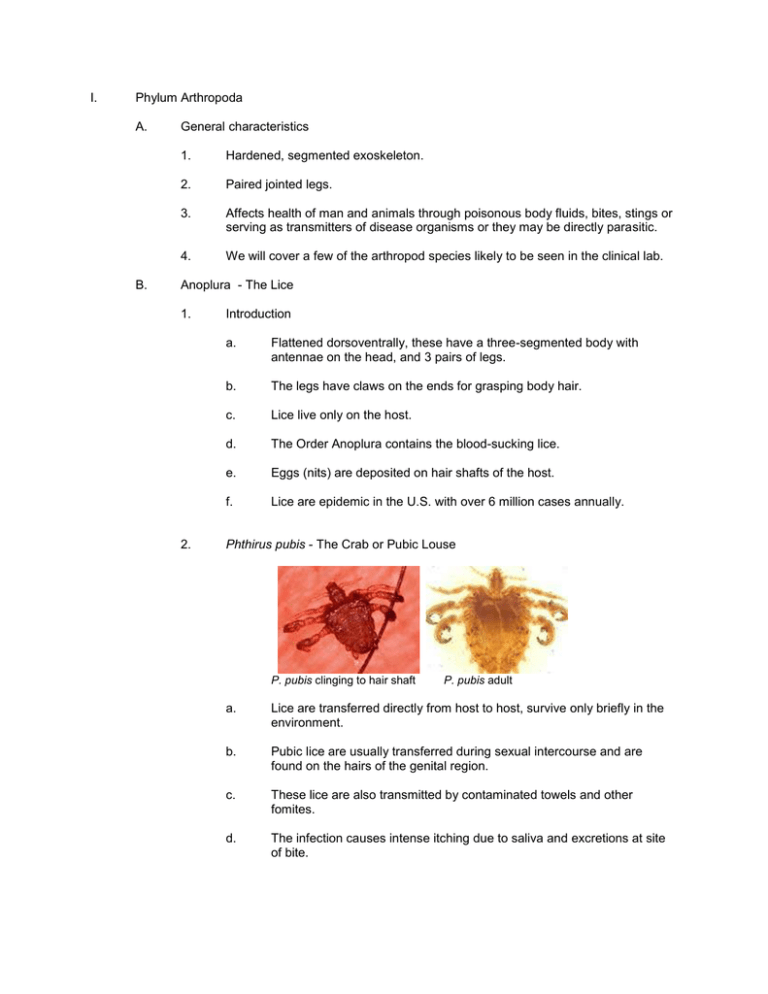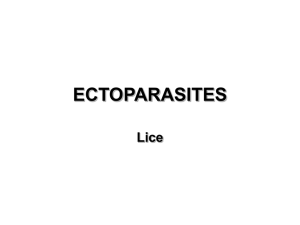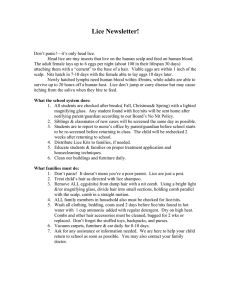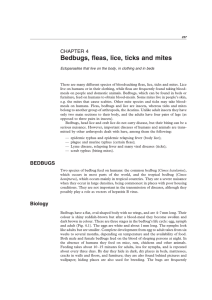I. Phylum Arthropoda A.
advertisement

I. Phylum Arthropoda A. B. General characteristics 1. Hardened, segmented exoskeleton. 2. Paired jointed legs. 3. Affects health of man and animals through poisonous body fluids, bites, stings or serving as transmitters of disease organisms or they may be directly parasitic. 4. We will cover a few of the arthropod species likely to be seen in the clinical lab. Anoplura - The Lice 1. 2. Introduction a. Flattened dorsoventrally, these have a three-segmented body with antennae on the head, and 3 pairs of legs. b. The legs have claws on the ends for grasping body hair. c. Lice live only on the host. d. The Order Anoplura contains the blood-sucking lice. e. Eggs (nits) are deposited on hair shafts of the host. f. Lice are epidemic in the U.S. with over 6 million cases annually. Phthirus pubis - The Crab or Pubic Louse P. pubis clinging to hair shaft P. pubis adult a. Lice are transferred directly from host to host, survive only briefly in the environment. b. Pubic lice are usually transferred during sexual intercourse and are found on the hairs of the genital region. c. These lice are also transmitted by contaminated towels and other fomites. d. The infection causes intense itching due to saliva and excretions at site of bite. 2. Pediculus humanus - The Head or Body Louse P. humanus adult 4. P. humanus nit a. The infection is found wherever personal or general hygiene is at a low level. Transmission is achieved by coming into contact with personal items from infected people. b. The entire life cycle occurs on humans. The female lice deposit their eggs on the hair, where they are firmly attached. c. The eggs (nits) are quite small and glistening white and may be seen with the naked eye. d. Nits mature and hatch in two weeks and the young louse begins feeding upon the hosts’ blood. e. Two subspecies are recognized, P. h. capitis infests the scalp and P. h. humanus (frequently called P. h. corporis) lives on protected parts of the body. f. The body louse may survive for more than a week in discarded clothing. g. Treatment consists of treating hair, clothing, bedding and all personal items. h. Body lice are important vectors of disease, transmitting epidemic typhus, trench fever and the louse-borne variety of relapsing fever. Sarcoptes scabei The Itch Mite S. scabei adult a. Cause of scabies, or “7 year itch.” b. Cosmopolitan in distribution, with a global prevalence of about 300 million cases. c. It parasitizes both domestic animals and humans, causing scabies in humans and mange in animals. d. Life cycle e. (1) After copulation the female burrows a tunnel into the epidermis at a rate of 2 to 3 mm/day, producing a channel 3 cm long. (2) She deposits large eggs into the tunnel for 4 to 5 weeks. (3) An intense itching is caused by irritating excrement. Scratching results in formation of lesions which may lead to secondary bacterial infections. (4) Newly hatched larvae reach adulthood in one week. The short life cycle allows infestation to become severe before treatment begins. Diagnosis is made by finding eggs, nymphs or adults in skin scrapings from around lesions.





